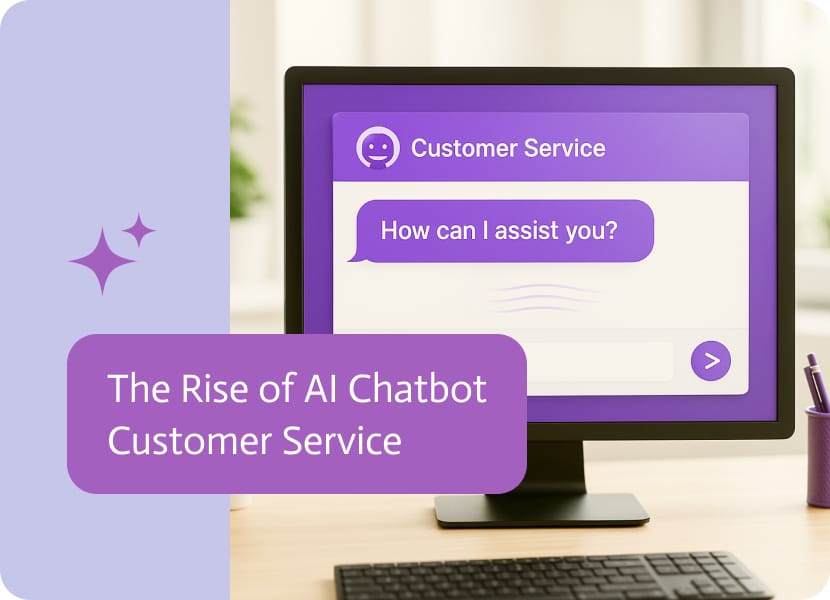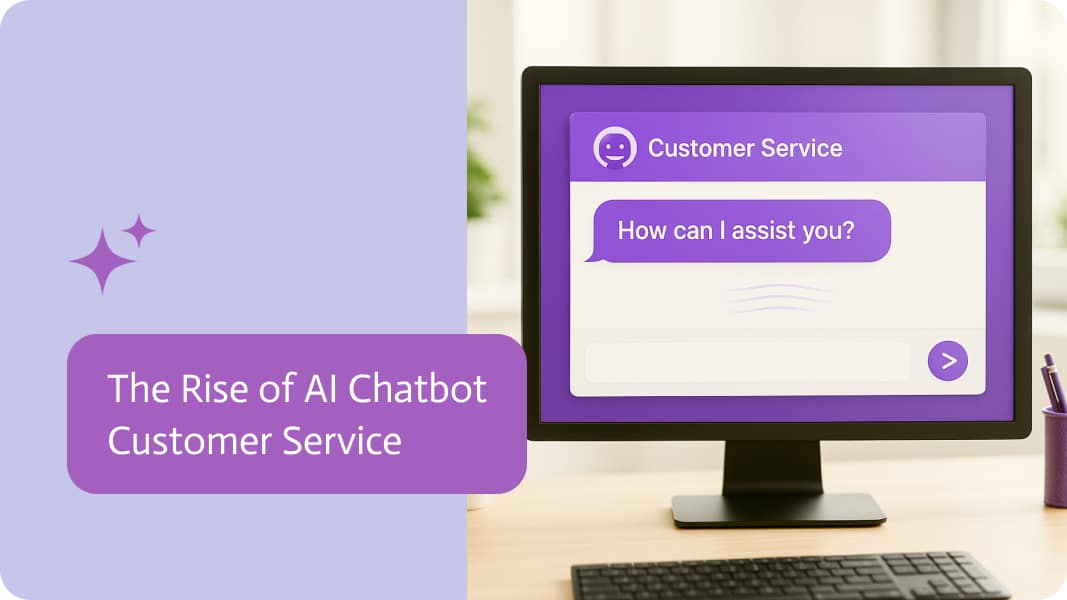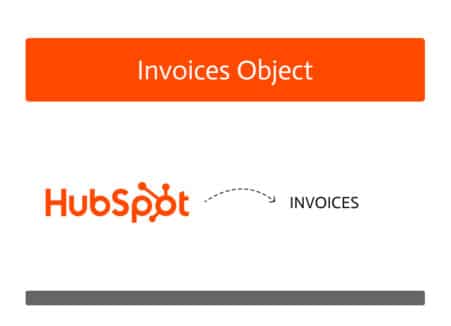

The Rise of AI Chatbot Customer Service
From clunky scripts to conversational intelligence, why businesses are all-in on AI support.
For a long time, dealing with customer service has felt more like a chore than a treat. Between the endless hold music, cookie-cutter email replies, and confusing online help guides, it’s hard to picture anyone jumping for joy. Companies set up big teams to answer calls, yet that plan keeps cracking under the weight of rising customer demands and never-ending digital chats.
What Is an AI Chatbot?
To see how it helps customers, let’s be clear about what an AI chatbot really is. It’s not the old pop-up that only points you to an FAQ or that clunky menu tree from 2015. The new version uses advanced tech to grasp everyday language, hold back-and-forth chats, and lend a hand on websites, apps, social channels, or even voice speakers.
With prompt to chat bot, simple natural-language instructions can be turned into actions the AI chatbot executes instantly, making interactions smoother and more efficient.
When it comes to AI chatbot customer service, it combines machine learning, natural language processing (NLP), and, when the budget allows, big models like GPT-4. By blending these tools, they scan a sentence for clues about what someone really needs, pull out the most important bits, and reply in a way that feels natural. They don’t just pick out keywords; they read the room, and many even save snippets from past chats so each new conversation gets a tiny bit smarter.
That constant give-and-take makes businesses eager to hand over repetitive work to these digital helpers, and to be clear, we’re talking about smart, talkative automation. AI chatbots are faster than any live agent, yes, but they also scale without limit, show up day and night, and keep the front lines of customer experience stocked and ready.
How People Use AI Chatbot Customer Service Today
These days, you can find an AI chatbot doing all sorts of jobs. In customer service, it often opens the door, waving hello to shoppers, fielding routine questions, and clearing up simple problems all on its own. Yet its skill set stretches far beyond just saying hi.
Online shopping sites now use bots to guide you from first-page scroll to final click, suggesting items based on what you’ve looked at before and nudging you back when you leave a cart full of shoes. In phone and software companies, similar bots step customers through address changes, explain surprising charges, and hand off tricky issues to a live agent the moment that’s needed.
Doctors’ offices and hospitals are training their own bots to ask simple quiz-like questions before an appointment, plug openings into a calendar, and ping patients later with well-you are all clear reminders. Airlines and booking apps automate flight reminders, send text alerts when a gate changes, and even process basic refund requests with the same kind of friendly chat. Because making a bot smarter is easier than ever, companies across sectors keep finding new ways it can save time and cut costs.
What used to feel like gimmicky chat windows is turning into real, everyday help that starts conversations instead of only waiting for them.
Inside the Machine: How It Works
Behind a powerful bot sit a few building blocks you rarely see but always rely on:
Intent recognition is the first step a chatbot takes to figure out what a customer wants. Whether the person is asking for a refund, booking an appointment, or checking delivery status, the bot tags that goal as a single, clear intent. More advanced systems even read the surrounding chat and learn to tell apart similar requests based on small clues in the phrasing.
Once the intent is clear, entity extraction digs deeper and picks out important bits, like order numbers, names, dates, or product types. By grabbing this information, the bot can pull up records, update details, or hand the query off to a human partner, all in real time.
Dialogue management is what keeps everything sounding smooth. If a user strays off-topic or suddenly changes their mind, a strong bot gently re-grounds the chat while still remembering previous points and functioning without pausing or losing context.
Many chatbots link directly to company systems, CRMs, help desks, inventory databases, or knowledge bases, so they are not only clever talkers; they are action tools that make everyday tasks faster and easier for both customers and agents.
Why Customer Service Was Ripe for Disruption
Customer service, by its nature, involves a high volume of repetitive, transactional interactions. Think of the thousands of customers asking:
- “Where’s my order?”
- “How do I reset my password?”
- “Can I change my subscription plan?”
- “Is there a return policy?”
Traditionally, each of these queries would either:
- It is handled manually by a live agent, costing time and money.
- Be ignored or delayed due to a lack of coverage, especially after hours.
- Be buried under a ticketing system backlog.
This repetition creates an ideal environment for automation, not just any automation, but intelligent, conversational automation. AI chatbots aren’t just faster—they’re designed to scale infinitely and operate 24/7 without fatigue, making them perfect frontline defenders in the customer experience war zone.
Business Impact: More Than Just Cost-Cutting
People often sell chatbots by pointing to the savings on payroll. That is true; handing boring, repetitive questions to a bot means firms need fewer agents sitting on phones all day. Yet the deeper gains come from lifting the entire quality and reach of customer care.
With an AI bot on the job, firms can serve customers day or night, weekend or holiday, without lining up staff in every time zone. Someone in New York, Tokyo, or Nairobi get an answer that same minute, even if it is 3 a.m. on a sleepy Sunday. In fast-growing teams, that kind of coverage lets service scale up without always scaling the payroll.
Speed is another huge win. Rather than waiting for a human to finish another call, customers usually see their answer in seconds. Research shows short waits boost satisfaction scores and lower churn right away.
The biggest benefit no one talks about is data. Each chat leaves behind clues about what people care about, where they freeze, which boxes break, and even how moods change week to week. When firms plug those threads into good analytics, they loop straight back into better products, sharper marketing, and a support team that knows what to fix first.
Noca’s Next Level Chatbot
The best businesses use chatbots to back up, not replace, their customer teams. When the bot hits its limit or faces a tricky case like an upset VIP with a billing problem-it passes everything it knows to a live agent: the chat transcript, notes on past purchases, and even little clues about how the customer is feeling.
Noca’s chatbot is setting the standard when it comes to AI driven chatbots that not only erase time wasting, but also perform tasks that were previously in the territory of Sci-fi movies. Imagine a chatbot that evolves with every question you ask, creates entire spreadsheets automatically, or finds open opportunities on Salesforce. This is just the tip of the iceberg, the future looks bright and Noca already has their sunglasses to navigate it.
Where the Tech Still Struggles
Still, AI chatbots are far from perfect.
They stumble on unclear language, especially when a comment is vague or loaded with emotion. When someone types, This is ridiculous, I can’t even log in, and your app keeps crashing, the bot may assume it’s a password issue; unless it’s trained to spot frustration, sarcasm, or urgency, the reply will miss the mark.
Chatbot performance still rides on how well they’re trained. A bot built without real use case mapping ends up feeling clunky, unhelpful, or, even worse, infuriating. Over-automation looms, too. If companies shove every question to a bot with no escape hatch to a real human, customers feel trapped-and that tanks brand perception.
For these reasons, best practice now talks about intelligent fallback logic, clear escalation paths, and regular audits of what the bot gets wrong.
The Road Ahead: Smarter, Kinder Bots
The next wave of AI chatbots will know the context of a conversation and read emotion better-in near real time. We already see hints of this change in sentiment engines and big language models that tune tone to match a brand’s voice.
Voice-led bots are coming fast. As speech tech perfects itself and processors shave lag time, call centers will bend into AI-first hubs where live agents step in only when needed.
Look for bots to be proactive, too. Instead of sitting still until a user hollers about a problem, a smart assistant might spot a canceled flight, an expired subscription, or a low balance-and offer a fix before panic sets in.
Soon, chatbots will move beyond simple answers and start building real, personal connections. They’ll remember what customers like, follow their history, and steer talks in a way that feels uniquely hers.
Final Thoughts
AI bots fix problems, but they also wipe out waiting lines, add a human touch, and keep businesses moving. As the tools get smarter and companies learn the ropes, the real question shifts: how quickly can you plug them in before some other brand beats you to it?


